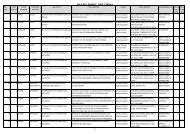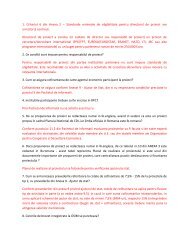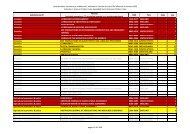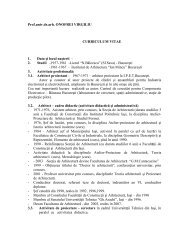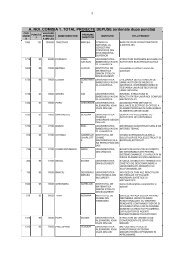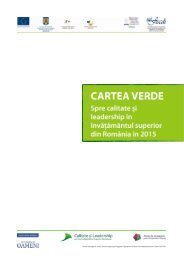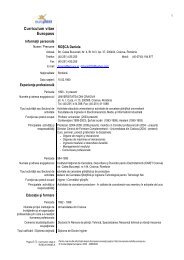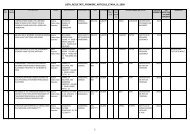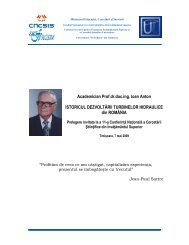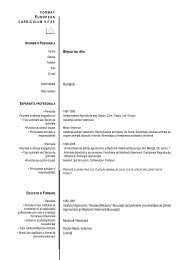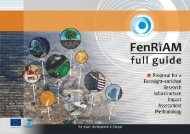Povesti de succes - uefiscdi
Povesti de succes - uefiscdi
Povesti de succes - uefiscdi
You also want an ePaper? Increase the reach of your titles
YUMPU automatically turns print PDFs into web optimized ePapers that Google loves.
Centrul <strong>de</strong> Neurobiologie şi Fiziologie Moleculară<br />
34<br />
Profesor univ. dr. Maria-Luiza Flonta<br />
Universitatea din București<br />
Telefon:+40 021 3181574<br />
Fax: +40 021 3181573<br />
Email: flonta@biologie.kappa.ro<br />
Prezentarea activităţii <strong>de</strong> cercetare<br />
Centrul <strong>de</strong> Neurobiologie şi Fiziologie Moleculară<br />
Research Center in Neurobiology and Molecular Physiology<br />
În Centrul <strong>de</strong> cercetare în Neurobiologie (http://neurobiologie.bio.unibuc.ro)<br />
se fac studii <strong>de</strong> tip analitic a moleculelor<br />
implicate în funcționarea sistemului nervos, în<br />
special a canalelor ionice și transportorilor implicați în<br />
generarea durerii, termorecepție sau a unor disfuncții psihice<br />
cum ar fi <strong>de</strong>presia. Se utilizează tehnici performante ca:<br />
menținerea neuronilor în culturi primare, tehnici electrofiziologice<br />
prin care se înregistrează fluxurile <strong>de</strong> ioni<br />
printr-un singur canal ionic situat pe membrana neuronală<br />
(metoda patch-clamp), imagerie prin fluorescență care permite<br />
măsurarea și vizualizarea fluxurilor <strong>de</strong> calciu cu rol în<br />
semnalizarea intracelulară, mo<strong>de</strong>larea pe calculator a interacțiilor<br />
moleculare <strong>de</strong> tip ligand-receptor, tehnici <strong>de</strong> biologie<br />
moleculară.<br />
Proiectele <strong>de</strong> cercetare în <strong>de</strong>rulare sunt:<br />
- Caracteristicile <strong>de</strong> activare ale canalelor ionice<br />
(TRPV1, ASIC, Na, K) implicate în generarea senzației <strong>de</strong><br />
durere.<br />
- Mo<strong>de</strong>larea matematică a activității electrice a neuronilor<br />
și a cardiomiocitelor cu aplicații în predicția aritmiilor<br />
și a raspunsului la antiaritmice.<br />
- Studiul modificărilor <strong>de</strong> excitabilitate a neuronilor din<br />
ganglioni dorsali spinali în condiții <strong>de</strong> axotomie sau inflamatorii.<br />
- I<strong>de</strong>ntificarea mecanismelor ce potentează activitatea<br />
canalelor implicate în excitabilitatea sistemului nervos periferic<br />
în condiții <strong>de</strong> neuropatie diabetică.<br />
- Depen<strong>de</strong>nța <strong>de</strong> temperatură și modularea activității<br />
canalelor ionice termo-sensibile din familia TRP (transient<br />
receptor potential).<br />
- Mo<strong>de</strong>larea moleculară a interacțiilor dintre medicamentele<br />
psihotrope și receptorii dopaminergici sau serotoenergici.<br />
- Profil psihocomportamental și performanța cognitivă<br />
la șoareci normali, transgenici și dublu transgenici.<br />
- Aplicațiile nanofosforilor în domeniul biomedical.<br />
- Investigarea mișcărilor colective <strong>de</strong> frecvență joasă ale<br />
proteinelor, prin meto<strong>de</strong> <strong>de</strong> dinamică moleculară și analiză<br />
<strong>de</strong> moduri normale. Construirea unui mo<strong>de</strong>l 3D al canalului<br />
epitelial <strong>de</strong> sodiu (ENaC).<br />
Brief Presentation of Research Activity<br />
The research centre in Neurobiology (http://neurobiologie.bio.unibuc.ro)<br />
consists in several laboratories investigating<br />
the molecular and cellular basis of nervous system<br />
function, with an emphasis on ion channels and transporters<br />
involved in acute and chronic pain signaling, and psychiatric<br />
disfuctions such as <strong>de</strong>pression. Our experimental approaches<br />
are based on mo<strong>de</strong>rn electrophysiological methods, such as<br />
patch-clamp, calcium microfluorimetry, computer mo<strong>de</strong>ling<br />
of ligand-receptor interactions and advanced molecular<br />
biology techniques.<br />
Among the ongoing research projects are the following:<br />
- Biophysical properties of ion channles involved in pain<br />
transduction (TRPV1, ASIC, voltage gated Na and K channels)<br />
- Computer mo<strong>de</strong>ling of electrical activity in neurons<br />
and cardiomyocites, aiming at predicting arythmias and responses<br />
to anti-arythmic agents<br />
- Investigation of the changes in peripheral neuronal excitability<br />
following axotomy or inflammation. Setting up of<br />
mo<strong>de</strong>l systems for testing potential anti-inflammatory and<br />
analgesic compounds<br />
- Mechanisms involved in sensitization of pain signaling<br />
ion channnels in peripheral diabetic neuropathy<br />
- Investigation of the temperature <strong>de</strong>pen<strong>de</strong>nce and modulation<br />
of thermally gated TRP (transient receptor potential)<br />
channels<br />
- Molecular mo<strong>de</strong>ling of interactions between antipsychotic<br />
agents and dopaminergic and serotonergic receptors<br />
- Behavioural profiling and cognitive performance<br />
testing in wild type and various transgenic mice<br />
- Applications of nanophosphores in biomedical research.<br />
- Investigation of low frequency collective movements<br />
of marker proteins using molecular dynamics techniques and<br />
normal mo<strong>de</strong> analysis. Building a 3D mo<strong>de</strong>l of the epithelial<br />
sodium channel (ENaC).<br />
- Building 3D mo<strong>de</strong>ls for wild-type and mutant human<br />
tryptophan-hydroxylase 2 (TPH2); investigation of its inter-



